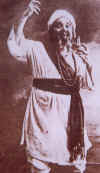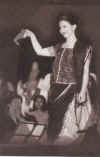|
|
|
||||
|
APRIL 2002 Contents
Travel 'Baikunth'
- the mountain Literature Visual Arts Jatin
Das - 4 decades of Music Zakir
Hussain - Compelling Hakim
Ajmal Khan's ancestral Business & Economy Performing Arts 'Fakir
of Benares' -1922 French Films Revathy
Menon's 'Mitr - my Books 'Knock
at Every Alien Door' People
Books
|
|
|
|||
| print gallery | |||||
|
'THE FAKIR OF BENARES' by Sanjeeb Mukherjee
One of the biggest theatrical hits of its time, the 1922 French opera The Fakir of Benares has been revived by a team of Indo-French artistes under the direction of Muzaffar Ali.
In 1922, when India was still a British colony with some French territorial turf, playwright Leo Manuel, bewitched by the charms of the holy city of Benares went back to France and created a musical masterpiece set in Benares. It was an instant hit and is still remembered as one of the most successful operas of the country. Now, eighty years later, the opera is revived and resurrected by Priya Wacziarg, daughter of the noted French author, historian and restorer, Francis Wacziarg who has made India his home. No one knows the exact history of the opera though, and how a story with such definitive Indian overtones travelled across the seas to reach France. What is established though is that the opening show of the opera was held in April 1922 at the famous Mondador theatre in Paris. From its very first performance, crowds thronged the theatre to see the opera and hear its songs. Soon enough, The Fakir Of Benares became the talk of Europe. Sadly, within a few weeks of its running to packed halls, the theatre went up in flames that destroyed everything including the priceless sets and costumes. The devastating flames swallowed up the entire place and turned everything into ashes. The only remnants were a few half burnt manuscripts of the opera. Along with the manuscripts, the writer of this fabulous opera too appeared to have been extinguished and lost in wilderness, but the tale that he left behind of love, sacrifice and loyalty has survived the initial stirrings of the audience’s heartstrings. Magical Powers The Fakir of Benares is the story of Sundra, an ugly young lady of Benares cast off by society, but with a deep longing to love and be loved. Sundra meets Kandour, a very handsome blind man on the look out for an affectionate companion and a guide. The two come together and love blossoms, a love that seems blessed by the Gods, until the arrival in Benares of Alibeck, a fakir, who claims to have special magical powers to cure any kind of disease. Kandour falls on the feet of the Fakir and begs him to cure his blindness so that he could see the woman he loves so much. The ugly Sundra is startled and tries to convince Kandour that external beauty is not as important as the internal beauty. But Kondour would have none of it and asks her to help him apply the magic balm given by the Fakir on his eyes. Afraid that her lover will reject her once he sees her, Sundra covers her face with her hands as Kandour’s sight returns. What unfolds after this is a tragic and poignant tale of betrayal and rejection. In its original avtar, The Fakir of Benares was nearly two hours long with an all-French cast. Even the costumes were distinctly Parisian in design. And despite the very strong Indian flavour and cultural ethos, French artists were signed up for the opera. In 2001, Priya Wacziarg, a soprano, stumbled upon the manuscripts in a dusty bookshop of Paris, and decided to revitalize the entire piece. But the manuscript was incomplete and very little information was available on the orchestration of the opera. Priya shared the manuscripts with noted French composer
Frederick Ligier, who Priya’s father Francis Wacziarg reverted to his long time friend, eminent filmmaker, Muzzaffar Ali to direct the opera. Work began in April 2001 and now the opera is complete. Says, Priya, "The most difficult part was the casting. We really had to finalize it by a hit and trial method as we had no information on the background of actors in the original opera." But, after painstakingly tying up all the loose ends, she has finally managed a star cast that is a unique blend of Indian and French artists. Priya herself is playing the lead role of Sundra, Fredrick Polivet is Kandour, Jasmin Martorell plays the Fakir Alibeck, noted danseuse Aditi Mangaldas plays the role of court dancer. The fusion of artists from the two cultures brought in this unique characterization and blend of India and France in the opera. Indian Framework Since the opera is set in a very typical Indian framework and is being screened in India for the first time, director Muzaffar Ali has peppered the scenes with classical Indian dances to maintain the right balance between the French and Indian culture.
Ali was very particular not to change the essence of the opera, which was French. " The classical dance forms have been incorporated keeping in mind the need of the situation. When the opera is seen, these insertions that I have made do not seem at all to be disjointed," says Ali. Apart from classical dances and songs, Indian musical instruments too have been introduced in the musical compositions. " To highlight the element of Indianness in the opera we have even played shehnai at the end of the opera," says Francis Wacziarg. This is the first time that Indian and French artists are working together and wooing the Indian audience for a first-ever opera experience before taking it to Paris, London and New York. But more than that the opera has flagged off a new age of cultural fusion between India and France. As Francis Wacziarg, who has lived in India for the last 32 years says, "My motherland is France, but my place of work has been India. Through this opera I want to pay my tribute to both of them." As for Priya " I have been overwhelmed by the response.
This could be the next big thing to happen to Europe - and America
after." _______________________
|
|||||
| Copyright © 2000 [the-south-asian.com]. Intellectual Property. All rights reserved. | |||||
| Home | |||||



